A board I designed has a noise problem that is caused by an onboard GSM/GPRS module (the Quectel M66 [1]). This module is connected to a Siretta Delta 2C [2] dipole antenna via 20cm coax cable. The image below shows the layout around the GPRS module:
The GPRS module itself works fine: the signal strength is good and sending/receiving data is no problem.
The problem
We have a few 24-bit ADCs on the board that pick up noise spikes when the GPRS module is connecting to the network. This noise seems to be caused by the antenna and the coax cable.
 Noise spikes caused by GPRS module (see the middle of the plot).
Noise spikes caused by GPRS module (see the middle of the plot).
Observations
The problem still exists if the GPRS module is powered independently from the rest of the circuit.
The noise only seems to occur when connecting and disconnecting from the network, not while using the connection (sending data).
Adding a one meter coax extension cable suppresses the noise, except when it is positioned in a straight line. This is even the case when the antenna is in the same position as before.
Ferrite beads around the coax cable suppress the noise a bit, but not completely. Maybe a lot of ferrite beads, or another type of beads would be sufficient. Unfortunately these beads are quite large. Adding multiple of them will not fit into the product.
Placing the antenna directly on top of a large sheet of aluminium works quite well, but only if the sheet is in direct (conducting) contact with the antenna. Maybe this forces the dipole antenna to become a monopole + GND plane?
Edit: Even with the antenna disconnected (just the 20cm of coax), the module works as intended, no noise on the ADCs. Even though the module uses more power in this configuration.
Unfortunately the above workarounds are not very practical or reliable enough to use as a real solution.
Hypothesis
I am more and more convinced the problem may be related to common-mode RF current on the coax cable. This seems to come up often when searching for driving a dipole antenna with a coax cable.
Help!
Does this hypothesis make sense considering the situation and observations? Are there other likely causes that could explain these observations? And finally, what can I do about it?
Edit: about the power supply
The GPRS module can draws large current spikes up to about 2A. In an effort to keep these currents away from the ADCs, the latest board revision buffers most of the power with a large capacitor, as shown in the schematic:

simulate this circuit – Schematic created using CircuitLab
The main power supply only has to deliver up to about 300-400mA. This is enforced by a current limiting IC in series with the power supply. A large electrolytic capacitor buffers the current peaks. The last step is a 4V LDO to keep the voltage on the GPRS module steady at 4.0V. A total of 80uF of ceramic capacitors is placed directly on the 4V power input of the GPRS module.
When the module is sending, the LDO output drops by 60mV. The Quectel M66 datasheets recommends a maximum drop of 400mV. Unfortunately I do not have enough reputation yet to add more pictures
[1] http://www.quectel.com/product/prodetail.aspx?id=73
[2] http://www.farnell.com/datasheets/1877150.pdf
